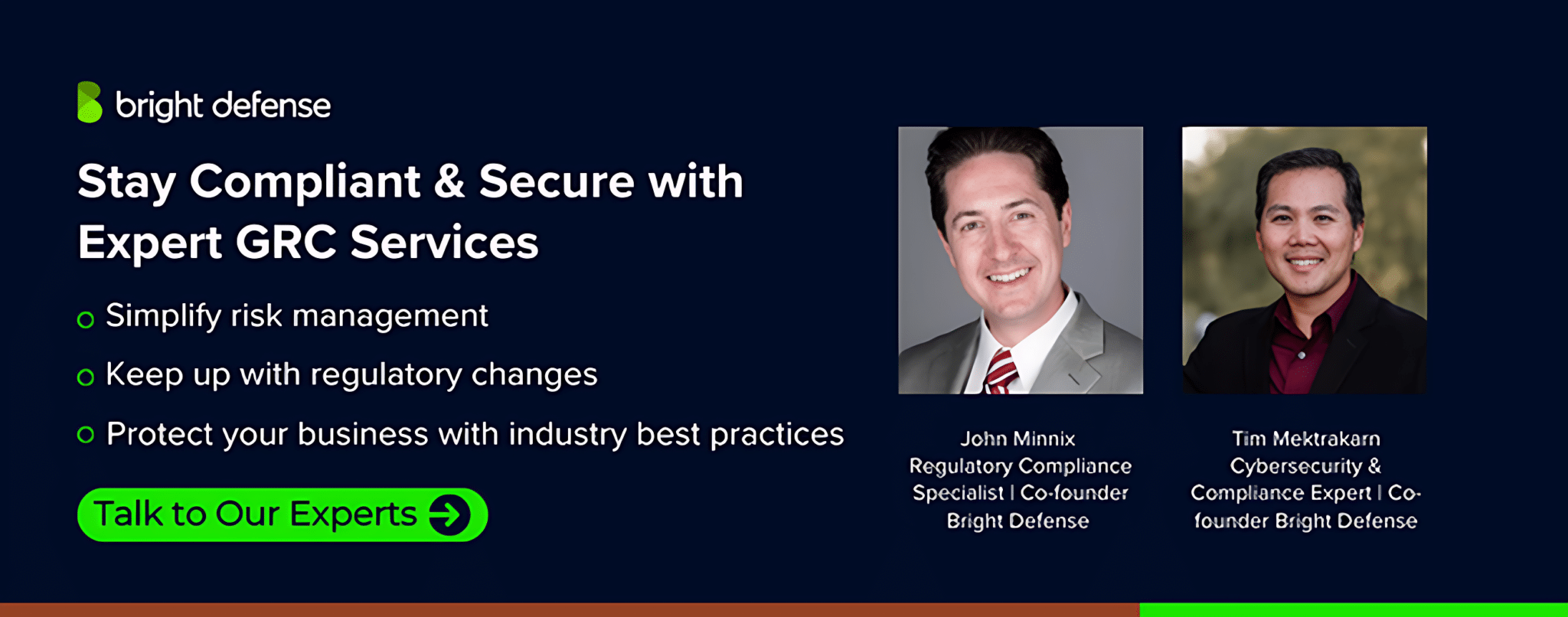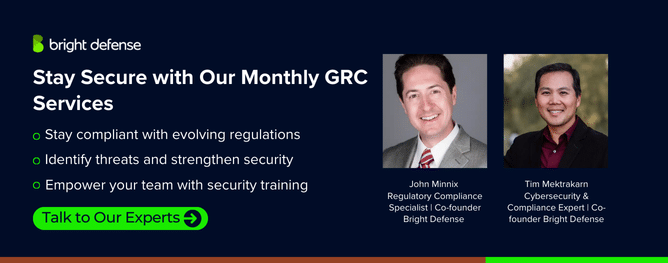Tamzid Ahmed
February 1, 2025
What is GRC in Cybersecurity and Why Is It Crucial Now?
GRC in cybersecurity stands for Governance, Risk, and Compliance. It is a framework that helps organizations manage their cybersecurity efforts efficiently.
Governance focuses on keeping policies, processes, and roles consistent with the organization’s goals. Risk management involves identifying, addressing, and reducing cyber threats to minimize harm. Compliance focuses on adhering to laws, regulations, and industry standards like GDPR or HIPAA. Together, GRC provides a structured approach to protect sensitive` data, address risks, and meet regulatory requirements.
With 60% of organizations experiencing at least one data breach in the past year and 60% struggling to meet compliance requirements, GRC undeniably stands as one of the most crucial elements of cybersecurity at this moment.
In this blog post, we will discuss everything there is to know about GRC.
Let’s dive right in!
Key Takeaways
- 60% of organizations experienced a data breach last year, showing the need for strong GRC practices to manage cybersecurity risks and compliance.
- GRC helps businesses manage risks, follow regulations, and keep security policies in line with business goals.
- 40% of organizations expect major cyber threats, making risk management through qualitative and quantitative assessments essential.
- Compliance with regulations like GDPR, HIPAA, and ISO 27001 is critical to avoiding penalties and maintaining trust.
- 62% of organizations now see risk as an opportunity rather than just a threat, using GRC strategies to strengthen security.
- GRC tools like Bright Defense and Archer help businesses with compliance, risk tracking, and security governance.
The Three Elements of GRC
Let’s look at the three specific factors that make up GRC and discuss each one in greater detail:
1. Governance
Governance is the system an organization uses to manage and regulate its operations. It includes policies, rules, frameworks, and the organizational culture that guide behavior and decision-making. Here’s how governance plays a role:
- Clear Policies on Acceptable Use: Can employees install random software on work systems? Visit any website during their breaks? Connect gaming consoles to the network? Governance lays out clear rules to address these scenarios, ensuring consistency and security. Without these guidelines, organizations risk security breaches and operational chaos.
- Behavioral and Organizational Guidelines: Governance shapes how employees and IT resources operate, defining what is acceptable and expected within the organization.
- Ethics and Accountability Frameworks: It also promotes ethical conduct and accountability by introducing codes of ethics, performance evaluations, and compliance measures. For instance, it might require employees to declare conflicts of interest or report gifts received during work-related activities.
- Open and Consistent Information Sharing: Governance ensures transparency by mandating regular updates on budgets, projects, or policy changes. At the same time, it safeguards sensitive information, fostering trust and enabling public scrutiny.
- Defined Conflict Resolution Processes: With governance in place, organizations have clear protocols for addressing disputes. This includes steps for filing grievances, mediation processes, and escalation procedures to handle conflicts fairly.
- Not Just Rules, but a Cultural Element: Governance isn’t about tools or technical skills; it’s about building an organizational culture backed by leadership. For example, if a company mandates encryption for all stored data, governance ensures compliance by addressing any violations through set consequences.
In essence, governance brings structure and accountability, ensuring that decisions and behaviors align with organizational values and goals.
2. Risk Management
Risk management refers to the understanding and management of potential threats and vulnerabilities that could impact an organization’s security. Nearly 40% of organizations surveyed by PwC anticipate significant cyber threats in the coming year, making risk management a crucial element within GRC and in cybersecurity as a whole. Risk management acknowledges that 100% security is unattainable due to various factors, such as:
- Human Vulnerabilities: Social engineering attacks.
- Technical Vulnerabilities: Exploitation of unpatched systems.
- Physical Security: Unauthorized physical access to systems.
Risk is assessed in two primary ways:
- Qualitative Risk: Assigns subjective labels to risks, such as “low,” “moderate,” or “high,” based on agreed-upon perceptions.
- Quantitative Risk: Uses measurable data to calculate risk levels. For example, an organization may determine that a specific control reduces risk from 34% to 17%. Decisions on acceptable risk thresholds, such as 20%, are made at the governance level.
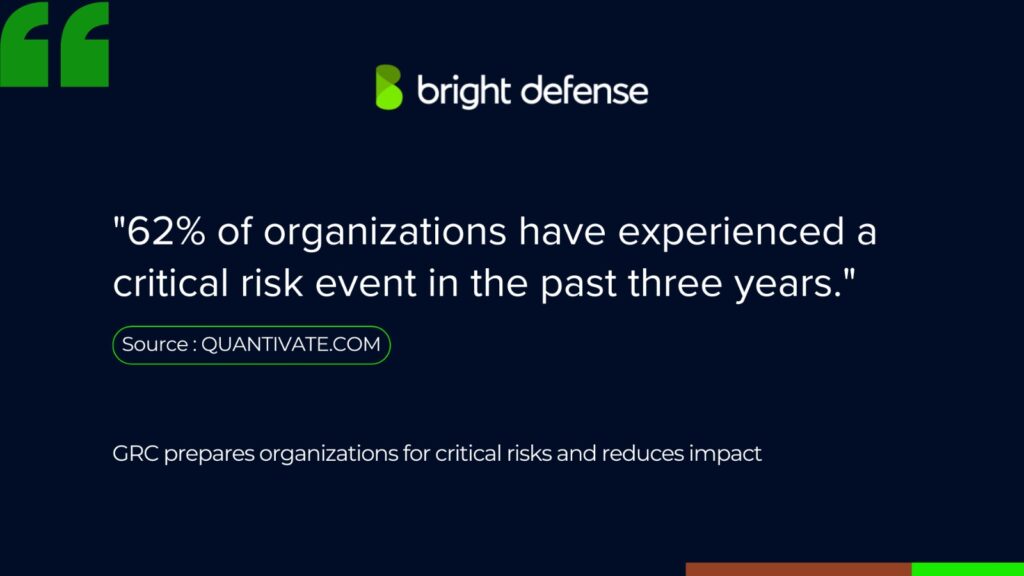
Effective risk management includes:
- Auditing: Testing the effectiveness of implemented controls.
- Remediation Plans: Addressing gaps and weaknesses found during audits.
- Leadership Reporting: Communicating risk status and mitigation efforts to leadership or the board.
For example, purchasing a firewall at Black Hat or implementing a new tool may seem like a security improvement, but without assessing its impact on the organization’s risk posture, it might just add to the budget without significant benefits.
3. Compliance
Compliance involves adhering to federal, industry, or organizational regulations and standards. It ensures that organizations meet minimum security and privacy requirements to avoid penalties and maintain operational capabilities.
I. SOC 2 (Service Organization Cont. rol 2)
Focuses on managing customer data securely based on security, confidentiality, and availability principles. Having SOC 2 compliance shows that an organization values data protection. Example: A cloud storage provider complies with SOC 2 standards to reassure clients that their data is safe and accessible.
II. ISO 27001 (Information Security Management System)
This international standard outlines the requirements for implementing, maintaining, and improving an organization’s information security practices. Failing to comply can expose businesses to data breaches and regulatory penalties. Example: A tech company handling sensitive user data implements ISO 27001 to minimize security risks and prevent reputational damage or fines.
III. PCI DSS (Payment Card Industry Data Security Standard)
If a business processes credit card payments, it must comply with PCI DSS. Non-compliance could result in losing the ability to accept credit card payments, severely impacting operations. Example: A food truck accepting credit cards must comply with PCI DSS to avoid being forced to switch to a cash-only model, which could hurt its business in a predominantly cashless society.
IV. HIPAA (Health Insurance Portability and Accountability Act)
In the healthcare sector, organizations must comply with HIPAA regulations to protect sensitive patient information. Non-compliance could lead to legal and financial penalties. Example: A hospital implementing a new electronic health record system must follow HIPAA regulations to keep patient records secure and avoid lawsuits.
V. CMMC (Cybersecurity Maturity Model Certification)
CMMC applies to companies working with the U.S. Department of Defense, requiring them to follow strict cybersecurity protocols to protect sensitive information. Example: A manufacturer bidding on defense contracts must obtain CMMC certification to remain eligible for federal projects.
VI. GDPR (General Data Protection Regulation)
GDPR regulates the privacy and protection of personal data in the European Union, with non-compliance leading to hefty fines and eroded customer trust. Example: A U.S.-based company serving EU customers complies with GDPR rules when collecting data on its website to avoid penalties and legal challenges.
Other important compliance frameworks include:
- NIST CSF (National Institute of Standards and Technology Cybersecurity Framework): A widely adopted framework for managing and mitigating cybersecurity risks.
- COBIT (Control Objectives for Information and Related Technologies): Provides guidelines for IT governance and management to align technology with business objectives.
- SOX (Sarbanes-Oxley Act): Ensures financial transparency and accountability for publicly traded companies.
- FISMA (Federal Information Security Management Act): Mandates U.S. federal agencies and their contractors to secure government data and systems.
- GLBA (Gramm-Leach-Bliley Act): Protects consumer financial data in the financial services industry.
- ISO 31000 (Risk Management Principles and Guidelines): Provides a framework for effectively identifying, analyzing, and addressing risks.
- CIS Controls (Center for Internet Security Controls): Offers prioritized actions to improve cybersecurity defenses.
Compliance often involves developing and following a minimum set of security controls, undergoing audits, and addressing gaps through an action plan. For instance, PCI DSS may require encrypting all credit card data. This policy would align with governance efforts, ensuring that encryption is enforced and deviations are addressed.
7 Reasnons Why GRC Important
GRC plays a pivotal role in shaping how organizations operate, make decisions, and safeguard their future. PwC’s Global Risk Survey 2023 revealed that 57% of organizations prioritize reviewing their risk landscape to prepare for upcoming technology investments, highlighting the growing importance of GRC in today’s evolving technological environment.
Here are 7 reasons why GRC is critical:
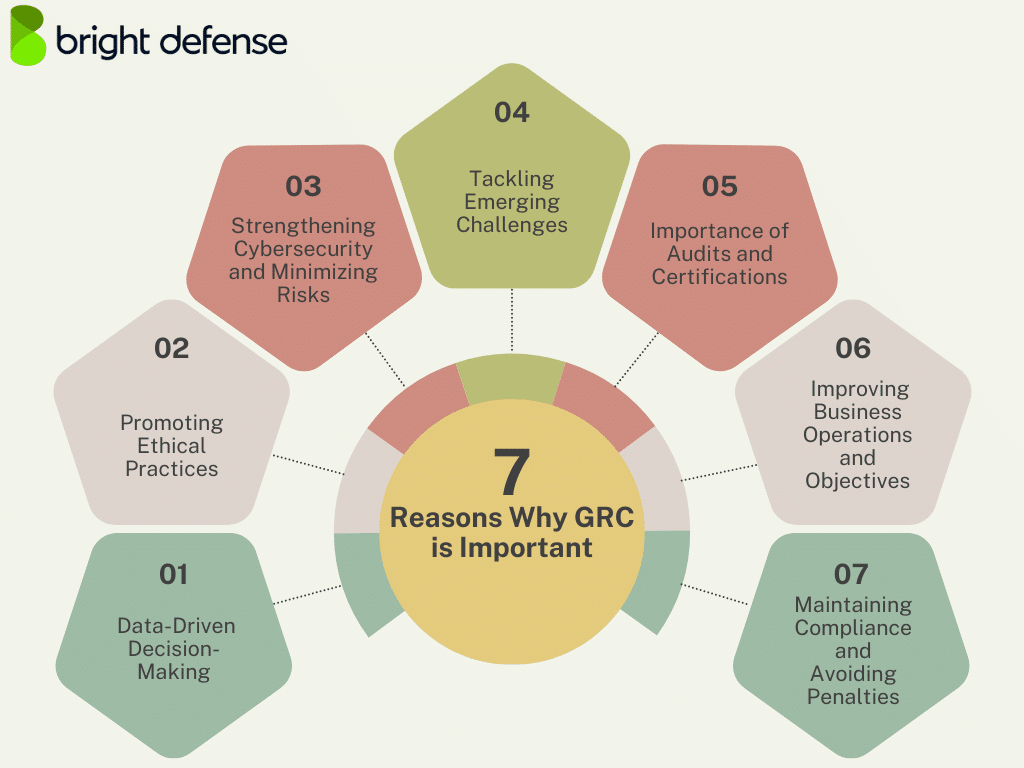
1. Data-Driven Decision-Making
GRC equips businesses with tools to make quicker and more informed choices. With GRC software, companies can track resources, assess risks, and implement policies based on real-time data, helping them make smarter decisions with confidence.
2. Promoting Ethical Practices
An effective GRC program fosters ethical behavior across the organization. Aligning operations with shared values creates an environment that supports sustainable growth and reinforces integrity in every action.
3. Strengthening Cybersecurity and Minimizing Risks
As cyber threats grow, GRC becomes critical for protecting sensitive data. With increasing cyber risks, organizations need a clear approach to identify, manage, and reduce risks. GRC tools and frameworks help businesses take a proactive stance on risk identification and mitigation, addressing vulnerabilities before they lead to data breaches or other critical issues.
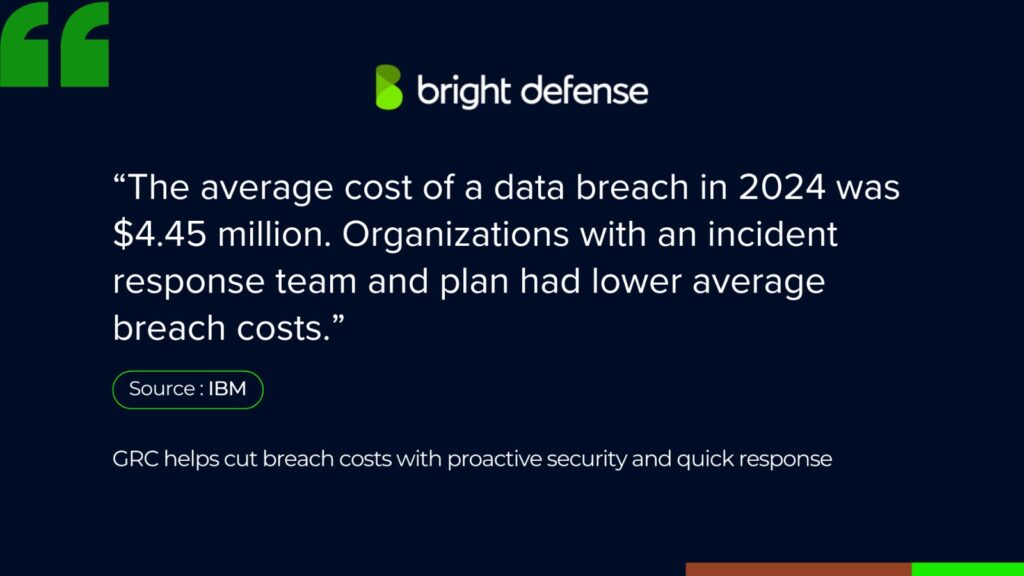
4. Tackling Emerging Challenges
As AI and new technologies continue reshaping industries, GRC’s role is becoming even more crucial. In this context, businesses must oversee AI use, audit its applications, and address the shortage of skilled GRC professionals. To that end, clear policies are essential for managing risks introduced by innovation while ensuring that security and compliance remain intact.
5. Importance of Audits and Certifications
Audits and certifications play a key role in demonstrating a company’s dedication to security and compliance. They offer clear advantages:
- Building Trust: Certifications like ISO 27001 and SOC 2 prove that your security practices meet global standards.
- Reducing Risk: Verifying that third-party vendors follow established protocols lowers the chances of data breaches or compliance issues.
- Staying Competitive: Certifications often tip the scales in your favor, as many clients prefer working with certified vendors over those offering extra features.
For instance, take the case of two HR software vendors. On one hand, one vendor offers advanced features but lacks certifications. On the other hand, the competitor may have fewer features, but it holds recognized certifications like ISO 27001 and SOC 2.
Given these points, clients often gravitate toward the certified vendor, prioritizing security assurance over additional functionality. This demonstrates how GRC plays a crucial role in business growth and strengthens client confidence.
6. Improving Business Operations and Objectives
A well-implemented GRC program not only connects cybersecurity efforts with business processes but also ties them to broader business objectives. This improves operational efficiency while strengthening the organization’s ability to meet strategic goals, all while maintaining security.
7. Maintaining Compliance and Avoiding Penalties
Regulatory compliance is especially crucial for organizations in industries like finance, healthcare, and government. After all, failing to meet these requirements can result in hefty fines and significant reputational damage. To that end, adopting an integrated approach not only ensures compliance with privacy regulations like GDPR but also strengthens customer trust. Moreover, it reduces the risk of legal and financial consequences, making it a necessary strategy for long-term stability.
How To Develop a GRC Strategy?
A GRC strategy is a well-structured plan that integrates an organization’s Governance, Risk Management, and Compliance efforts. By doing so, it ensures these functions work together seamlessly to support business goals, reduce risks, and meet regulatory obligations more effectively. Moreover, this approach fosters collaboration while also keeping organizations proactive in addressing challenges before they escalate.
Step 1 – Select Key Decision-Makers and Influencers
For executives, IT leaders, and compliance officers, playing a critical role in cybersecurity decisions is essential. After all, their involvement directly ties the GRC strategy to broader business priorities. By aligning these efforts, organizations can promote a unified and practical approach to governance, risk, and compliance, ensuring security remains a top priority without compromising business objectives.
Step 2 – Define Core Security Objectives
To build an effective GRC strategy, set precise and actionable goals that address governance, risk management, and compliance needs. This means assigning specific responsibilities, strengthening threat detection, and most importantly, creating a culture of accountability. To do this, implement regular training and awareness programs that help teams stay proactive against risks.
Step 3 – Audit Existing Processes and Spot Security Gaps
Conduct a detailed review of your current tools, workflows, and security frameworks. Pinpoint weaknesses, inefficiencies, and vulnerabilities that need immediate attention. This step builds the groundwork for a more reliable and effective cybersecurity strategy.
Step 4 – Prioritize Cyber Threat Management
Assess your organization’s risk tolerance and identify critical threats to systems and data. Moving from reactive measures to proactive planning allows for quicker risk mitigation and minimizes potential disruptions.
Step 5 – Build GRC Roadmap
Develop a roadmap specific to your organization’s challenges. Use benchmarks such as ISO 27001 or GDPR for guidance. Include actionable initiatives like improving endpoint security or protecting cloud-based systems, and break them into manageable steps with clear deadlines.
Step 6 – Maintain Continuous Monitoring and Adaptation
Treat cybersecurity as a dynamic, ongoing effort. To maintain strong defenses, regularly review and adjust controls, compliance activities, and risk management strategies. Given that cyber threats constantly evolve, staying flexible and proactive ensures your organization is prepared to tackle new challenges.
Example of a GRC Strategy in Action
An organization might implement a GRC strategy using a centralized GRC tool, conducting regular risk assessments, automating compliance tracking, and training employees on policies and procedures. In other words, this structured approach streamlines compliance, minimizes vulnerabilities, and keeps daily operations focused on long-term objectives. At the same time, it prepares the organization for audits and strengthens its ability to handle regulatory changes.
How to Implement GRC?
Here’s a straightforward guide to implementing GRC effectively.
Step 1: Assess Current GRC Processes
Start reviewing your existing GRC systems to find inefficiencies or disconnected workflows.
- Governance: Are policies transparent? Is management reviewing them regularly?
- Risk: What are the top risks, and how are they being mitigated?
- Compliance: Are employees trained on regulatory requirements?
Highlight areas needing improvement to create a clear starting point for GRC implementation.
Step 2: Develop a GRC Implementation Plan
Set GRC objectives that align with organizational goals. Your plan should include:
- A clear scope of work.
- Leadership support.
- Assigned team roles.
- KPIs to measure success.
- Training for employees.
- Adoption of automation tools.
This plan forms the foundation for an organized implementation process.
Step 3: Engage and Train Stakeholders
Appoint stakeholders to lead the implementation and clearly define their roles. Conduct training to help employees understand their part in achieving compliance and managing risks effectively. One thing to note, while risk was once solely viewed as something to be defended against, recent research found that a staggering 62% of organizations predominantly seek to uncover opportunities within risks, a departure from the previously practiced style.
This further underscores the importance of training your team with a new worldview towards risk – one that focuses on finding new opportunities within it.
Step 4: Select the Right GRC Technology
Choose GRC software that fits your organization’s needs. Look for features like:
- Automation for efficiency.
- Integration with existing systems.
- Ease of use.
Step 5: Execute GRC Initiatives in Smaller Scale
Carry out tasks based on priority, focusing on:
- Governance: Create clear policies and involve senior management in oversight.
- Risk: Perform assessments and develop mitigation plans.
- Compliance: Monitor regulations, collect evidence, and prepare reports.
Test your GRC framework on a smaller scale, such as within a single department or a manageable project. Use this initial implementation to refine processes, identify unforeseen issues, and build momentum. This phase helps secure additional stakeholder buy-in and confidence before rolling out the program organization-wide.
Step 6: Gradually Scale the GRC Program
Once the small-scale implementation is successful, expand the GRC program to larger or more complex areas of the organization. Apply lessons learned from earlier phases to improve the effectiveness and efficiency of the program. Scaling the framework gradually ensures that the organization adapts smoothly to new practices.
Step 7: Monitor and Improve
Treat GRC as a dynamic process by regularly reviewing and updating policies, processes, and controls. More importantly, adapt to evolving regulatory requirements, business strategies, and emerging risks. In light of ongoing industry shifts, gather feedback from stakeholders to identify areas for improvement and refine your approach. A continuous cycle of iteration makes sure that your GRC framework remains effective and relevant over time.
Key Components of a GRC Framework in Cybersecurity
- GRC Software and Tools: These tools assist in managing compliance data, automating risk assessments, and continuously monitoring security gaps.
- Risk Assessments: Regular assessments provide insight into potential threats, enabling organizations to focus on risk mitigation strategies.
- Compliance Management: This involves keeping track of regulatory changes, and implementing effective compliance frameworks.
- Structured Approach: A structured GRC process makes sure that all components, from governance to compliance, work together.
What is a GRC Tool?
A GRC tool is software designed to help organizations manage Governance, Risk, and Compliance processes. More specifically, these tools provide a centralized platform that simplifies risk assessment, compliance monitoring, and governance management. As a result, businesses can stay organized and meet regulatory requirements with greater efficiency. At the same time, a well-integrated GRC tool enhances visibility across operations, ensuring a proactive approach to risk and compliance.
What Are Some Common GRC Tools and Solutions?
Let’s check out some of the commonly used GRC tools and solutions:
1. Bright Defense: A Fully Managed GRC Service
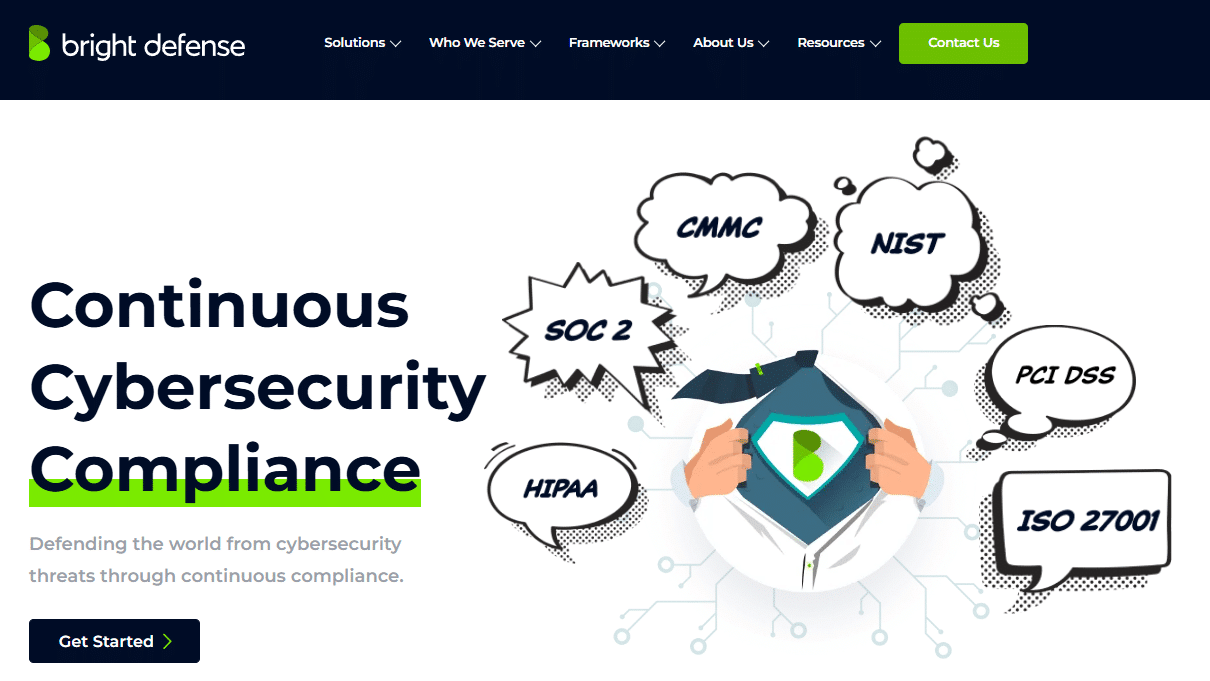
Bright Defense helps businesses meet and maintain compliance with major security frameworks, including SOC 2, ISO 27001, PCI DSS, HIPAA, GDPR, and more. Our CISSP and CISA-certified security experts create and execute customized cybersecurity plans, ensuring businesses stay protected and audit-ready.
Our monthly service includes:
- Continuous Cybersecurity Compliance – Risk assessments, policy implementation, business continuity planning, and remediation.
- Managed Compliance Automation – A single platform to monitor compliance across all frameworks in real time.
- Managed Security Awareness & Phishing – Employee training to reduce human risk factors.
- Virtual Chief Information Security Officer (vCISO) – Expert guidance to oversee cybersecurity strategy.
Bright Defense was built by managed service veterans who understand the unique challenges MSPs face, from security risks to budget constraints. That’s why our compliance solutions are designed to help service providers meet regulatory requirements efficiently without disrupting operations.
With Bright Defense, businesses can automate compliance, strengthen security, and stay ahead of evolving regulations.
2. Drata
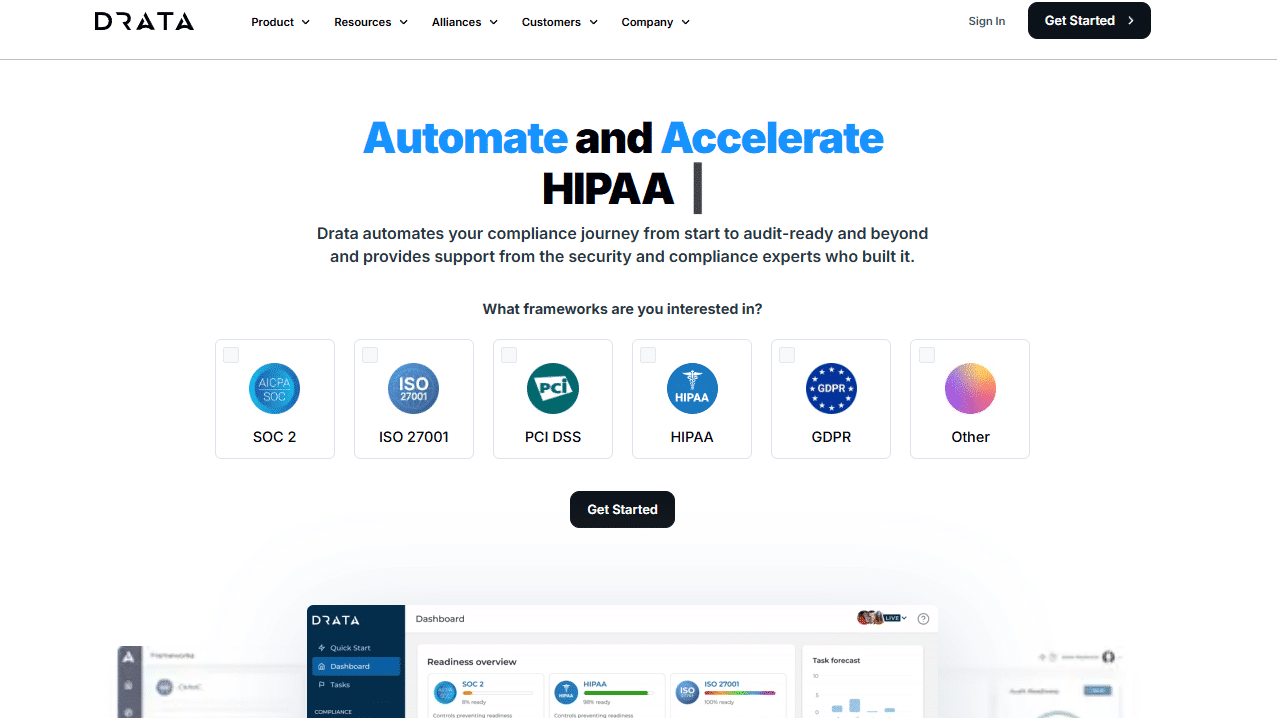
It helps businesses stay compliant from the start and remain audit-ready with automated workflows and real-time monitoring. Designed by security and compliance experts, it supports frameworks like ISO 27001, SOC 2, PCI DSS, HIPAA, and GDPR.
Startups tackling compliance for the first time, growing companies expanding security measures, and enterprises looking to add automation to their GRC programs all find Drata adaptable to their needs. Companies like Notion, Lemonade, and TaskRabbit rely on it to keep compliance on track without the extra hassle.
3. Archer
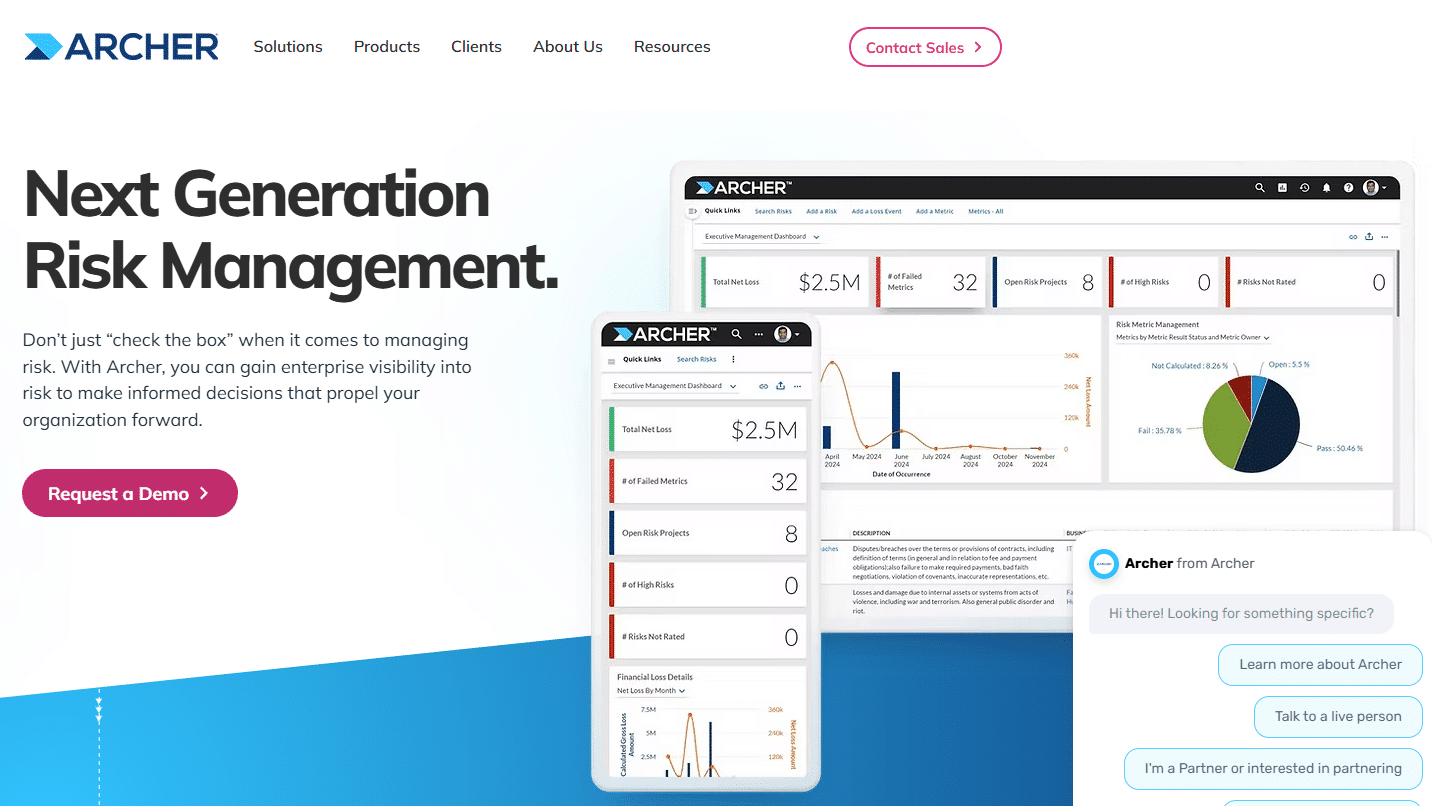
Archer is a well-known GRC platform offering solutions for risk management, compliance tracking, and audit management. One of its standout features is its flexibility, as it provides customizable workflows that adapt to specific organizational needs. In particular, its ability to scale makes it suitable for businesses of all sizes, ensuring a tailored approach to governance, risk, and compliance.
4. MetricStream
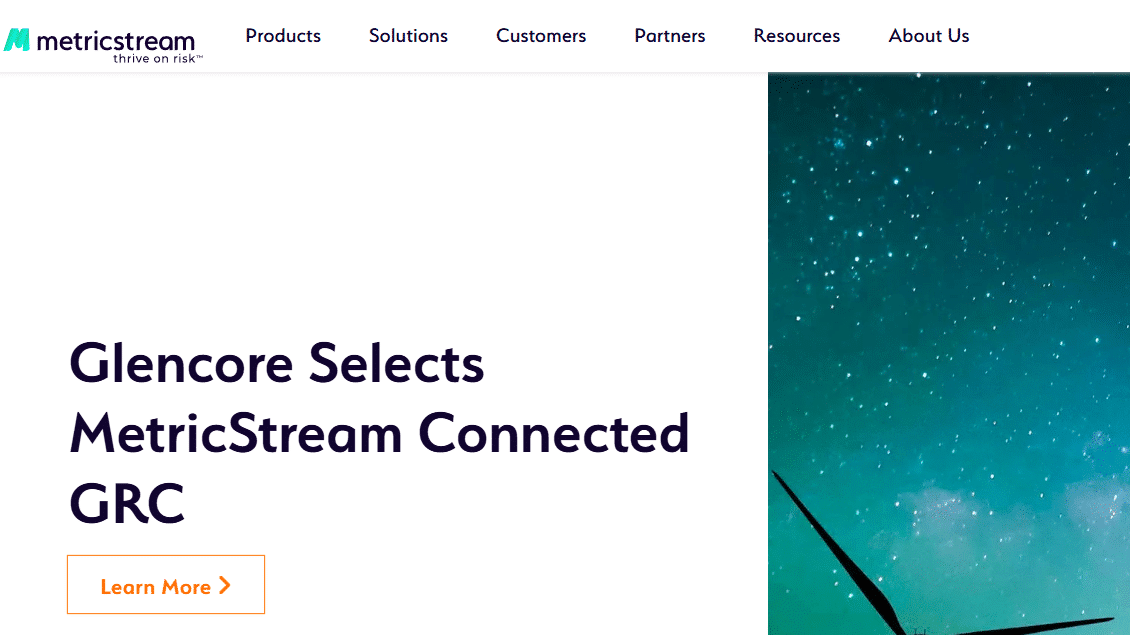
MetricStream focuses on enterprise risk management, compliance, and internal audits. It equips organizations with tools to evaluate and reduce risks, complemented by intuitive dashboards to monitor key performance indicators effectively.
5. LogicGate Risk Cloud
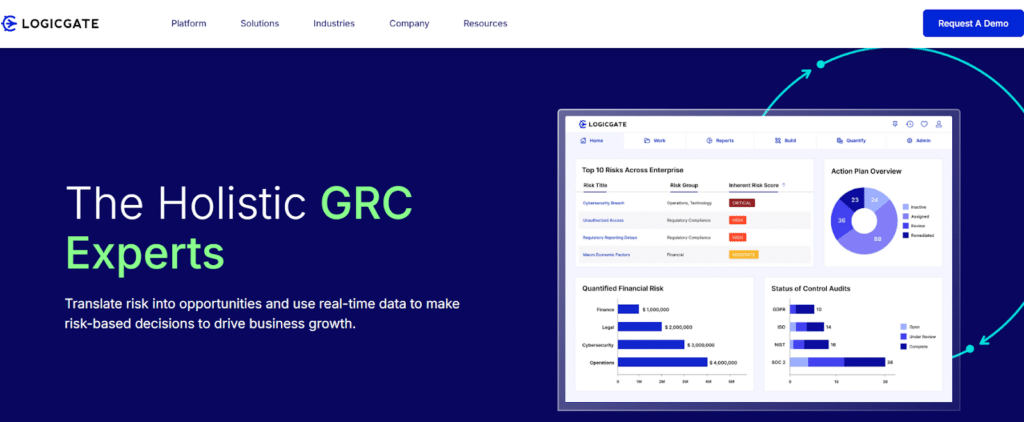
LogicGate Risk Cloud caters to risk management and compliance requirements with a user-friendly and highly visual interface. Its customizable workflows make it a versatile solution for businesses seeking tailored processes.
Final Thoughts
As cyber threats grow more advanced and regulations become stricter, Governance, Risk, and Compliance (GRC) has become essential to cybersecurity. It’s not just a system for meeting requirements—it’s a framework for protecting operations, reputation, and stakeholder trust.
GRC goes beyond shielding organizations from fines and breaches. It provides a way to manage risks, maintain compliance, and build confidence in security practices. In today’s unpredictable digital environment, the question isn’t whether GRC is needed—it’s how quickly organizations can put it into action.
With an effective GRC strategy, businesses can reduce vulnerabilities, strengthen decision-making, and secure long-term stability. For organizations looking to thrive in a changing cybersecurity world, GRC isn’t just helpful—it’s a necessity.
Need Help with GRC Implementation?
Bright Defense helps you meet your GRC objectives. Our services, including continuous compliance, penetration testing, and vulnerability management, address key GRC pillars. We help you manage risks, meet regulatory requirements, and maintain a strong security posture. Contact us for a free consultation.
Take the Next Step!
GRC Alignment: Our solutions conform to industry-leading frameworks such as NIST CSF and COBIT. This ensures your cybersecurity program supports your overall business objectives.
Risk-Based Approach: We concentrate on pinpointing and mitigating your most critical risks. This prioritizes your efforts for maximum impact and efficiency.
Continuous Improvement: We offer ongoing support and guidance. This helps you refine your GRC processes, adapt to evolving threats, and maintain compliance with changing regulations.
Start your GRC journey with Bright Defense. Contact us today to schedule a consultation and build a stronger, more secure organization.
Get In Touch


